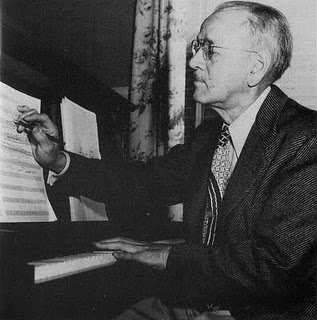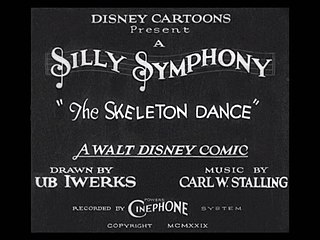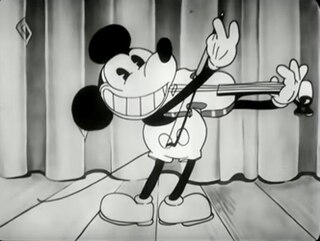
Mickey Mouse is an American cartoon character co-created in 1928 by Walt Disney and Ub Iwerks. The longtime icon and mascot of The Walt Disney Company, Mickey is an anthropomorphic mouse who typically wears red shorts, large yellow shoes, and white gloves. Inspired by such silent film personalities as Charlie Chaplin and Douglas Fairbanks, Mickey is traditionally characterized as a sympathetic underdog who gets by on pluck and ingenuity in the face of challenges bigger than himself. The character's depiction as a small mouse is personified through his diminutive stature and falsetto voice, the latter of which was originally provided by Disney. Mickey is one of the world's most recognizable and universally acclaimed fictional characters.

Ubbe Ert Iwerks, known as Ub Iwerks, was an American animator, cartoonist, character designer, inventor, and special effects technician, known for his work with Walt Disney Animation Studios in general, and for having worked on the development of the design of the character of Mickey Mouse, among others. Born in Kansas City, Missouri, Iwerks grew up with a contentious relationship with his father, who abandoned him as a child. Iwerks met fellow artist Walt Disney while working at a Kansas City art studio in 1919.

Oswald the Lucky Rabbit is an animated cartoon character created in 1927 by Walt Disney and Ub Iwerks for Universal Pictures. He starred in several animated short films released to theaters from 1927 to 1938. Twenty-seven animated Oswald shorts were produced at the Walt Disney Studio. After Universal took control of Oswald's character in 1928, Disney created a new character similar in appearance to Oswald as a replacement: Mickey Mouse, who went on to become one of the most famous cartoon characters in the world.

Plane Crazy is a 1928 American animated short film directed by Walt Disney and Ub Iwerks. The cartoon, released by the Walt Disney Studios, was the first appearance of Mickey Mouse and his girlfriend Minnie Mouse, and was originally a silent film. It was given a test screening to a theater audience on May 15, 1928, and an executive from Metro-Goldwyn-Mayer saw the film, but failed to pick up a distributor. Later that year, Disney released Mickey's first sound cartoon, Steamboat Willie, which was an enormous success; Plane Crazy was officially released as a sound cartoon on March 17, 1929. It was the fourth Mickey film to be given a wide release after Steamboat Willie, The Gallopin' Gaucho and The Barn Dance (1929).

Minnie Mouse is a cartoon character created by The Walt Disney Company. As the longtime sweetheart of Mickey Mouse, she is an anthropomorphic mouse with white gloves, a red or pink bow, blue polka-dotted dress, white bloomers and low-heeled shoes occasionally with ribbons on them. The Mickey Mouse comic strip story "The Gleam" by Merrill De Maris and Floyd Gottfredson first gave her full name as Minerva Mouse, although this is seldom used.
Silly Symphony is an American animated series of 75 musical short films produced by Walt Disney Productions from 1929 to 1939. As the series name implies, the Silly Symphonies were originally intended as whimsical accompaniments to pieces of music. As such, the films usually did not feature continuing characters, unlike the Mickey Mouse shorts produced by Disney at the same time. The series is notable for its innovation with Technicolor and the multiplane motion picture camera, as well as its introduction of the character Donald Duck making his first appearance in the Silly Symphony cartoon The Wise Little Hen in 1934. Seven shorts won the Academy Award for Best Animated Short Film.

Carl William Stalling was an American composer, voice actor and arranger for music in animated films. He is most closely associated with the Looney Tunes and Merrie Melodies shorts produced by Warner Bros., where he averaged one complete score each week, for 22 years.
The golden age of American animation was a period in the history of U.S. animation that began with the popularization of sound synchronized cartoons in 1928, began to decline around 1957, and ended by 1969, when theatrical animated shorts started to lose popularity to the newer medium of television. Animated media from after the Golden Age were produced on cheaper budgets and with more limited animation techniques by companies such as Terrytoons, UPA, Famous Studios, Jay Ward Productions, Hanna-Barbera, DePatie-Freleng Enterprises, Rankin/Bass and Filmation. In artefact, the history of animation became very important in the United States.

The Gallopin' Gaucho is a 1928 American animated short film and the second short film featuring Mickey Mouse to be produced, following Plane Crazy and preceding Steamboat Willie. The Disney studios completed the silent version in August 1928, but did not release it in order to work on Steamboat Willie. The Gallopin' Gaucho was released, with sound, after Steamboat Willie on December 30 of the same year.

The Skeleton Dance is a 1929 Silly Symphony animated short subject produced and directed by Walt Disney and animated by Ub Iwerks. In the film, four human skeletons dance and make music around a spooky graveyard—a modern film example of medieval European "danse macabre" imagery. It is the first entry in the Silly Symphony series. In 1993, to coincide with the opening of Mickey's Toontown in Disneyland, a shortened cover of the cartoon's music was arranged to be featured in the land's background ambiance. The short's copyright was renewed in 1957, and as a published work from 1929 it will enter the US public domain on January 1, 2025.

Mickey Mouse is a series of American animated comedy short films produced by Walt Disney Productions. The series started in 1928 with Steamboat Willie and ended in 2013 with Get a Horse!, taking a hiatus from 1953 to 1983. The series is notable for its innovation with sound synchronization and character animation, and also introduced well-known characters such as Mickey Mouse, Minnie Mouse, Donald Duck, Daisy Duck, Pluto and Goofy.

Wild Waves is a Mickey Mouse short animated film first released on December 18, 1929, as part of the Mickey Mouse film series. It was the fifteenth Mickey Mouse short to be produced, the twelfth of that year, as well as the last to be released by Celebrity Productions before Columbia Pictures took over distribution.

The Barn Dance is a Mickey Mouse short animated film first released on March 15, 1929, as part of the Mickey Mouse film series; it was the first of twelve shorts released during that year. It was directed by Walt Disney with Ub Iwerks as the head animator. The title is written as Barn Dance on the poster, while the full title is used on the title screen.

The Karnival Kid is a 1929 Mickey Mouse short animated film released by Celebrity Productions, as part of the Mickey Mouse film series. It was directed by Walt Disney and animated by Ub Iwerks, with music by Carl W. Stalling. It was the ninth Mickey Mouse short to be produced, the sixth of that year.
Fiddlesticks is a 1930 Celebrity Pictures theatrical cartoon short directed and animated by Ub Iwerks, in his first cartoon since he departed from Walt Disney's studio. The short features Iwerks' character Flip the Frog. It is the first complete sound cartoon to be photographed in color.

Steamboat Willie is a 1928 American animated short film directed by Walt Disney and Ub Iwerks. It was produced in black and white by Walt Disney Studio and was released by Pat Powers, under the name of Celebrity Productions. The cartoon is considered the debut of both Mickey and Minnie Mouse, although both characters appeared several months earlier in a test screening of Plane Crazy. Steamboat Willie was the third of Mickey's films to be produced, but it was the first to be distributed, because Disney, having seen The Jazz Singer, had committed himself to produce one of the first fully synchronized sound cartoons.

When the Cat's Away is a Mickey Mouse short animated film first released on May 3, 1929, as part of the Mickey Mouse film series. It was directed by Walt Disney and animated by Ub Iwerks and Ben Sharpsteen. It was the sixth Mickey Mouse short to be produced, the third of that year. In this cartoon, Mickey and Minnie are the size of regular mice, and Tom Cat is the size of a person.

Fiddlin’ Around is a 1930 animated short film produced by Walt Disney Productions and released by Columbia Pictures as part of the Mickey Mouse film series. It was the sixteenth Mickey Mouse short to be produced, the first of that year.

The Haunted House, also known as Haunted House, is a 1929 Mickey Mouse short animated film released by Celebrity Productions, as part of the Mickey Mouse film series. The cartoon was produced by Walt Disney Productions and distributed by Celebrity Productions. It was the fourteenth Mickey Mouse short to be produced, the eleventh of that year.

The Jazz Fool is a Mickey Mouse short animated film first released on December 21, 1929, as part of the Mickey Mouse film series. It was the twelfth Mickey Mouse short to be produced, the ninth of that year.


















